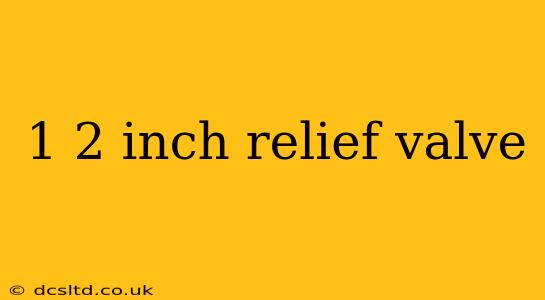A 1 1/2 inch relief valve is a crucial safety device used in various industrial and commercial applications to prevent pressure buildup beyond a predetermined limit. These valves automatically open when the pressure surpasses the setpoint, releasing excess fluid or gas and protecting equipment and personnel from potential damage or harm. This guide dives deep into the world of 1 1/2 inch relief valves, addressing common questions and providing crucial insights.
What are the different types of 1 1/2 inch relief valves?
Several types of 1 1/2 inch relief valves exist, each designed for specific applications and pressure requirements. The most common types include:
-
Spring-loaded relief valves: These are the most prevalent type, utilizing a spring to hold the valve closed until the set pressure is exceeded. They are relatively simple, reliable, and cost-effective.
-
Pilot-operated relief valves: These valves use a smaller pilot valve to control the main valve's opening and closing. They offer more precise pressure control and are often preferred in applications demanding higher accuracy.
-
Balanced bellows relief valves: Ideal for corrosive or viscous fluids, these valves employ a bellows to isolate the spring mechanism from the process fluid, preventing contamination and ensuring reliable operation.
-
Safety relief valves (SRVs): Often used in high-pressure applications, SRVs are designed to quickly and reliably release excess pressure to prevent catastrophic failures. They are typically subject to stricter regulations and testing requirements. The specific design and certification will depend on the application and relevant safety codes.
What is the purpose of a 1 1/2 inch relief valve?
The primary purpose of a 1 1/2 inch relief valve, like any relief valve, is safety. It protects systems and equipment from overpressure by venting excess fluid or gas when pressure exceeds the setpoint. This prevents potential damage, such as:
-
Equipment failure: Overpressure can rupture pipes, tanks, and other components, leading to costly repairs and downtime.
-
Personal injury: Excessive pressure can cause leaks or explosions, resulting in serious injury or even death.
-
Environmental damage: Uncontrolled releases of pressurized fluids can contaminate the environment.
How does a 1 1/2 inch relief valve work?
The operation of a 1 1/2 inch relief valve largely depends on its type, but the fundamental principle remains consistent. When the system pressure surpasses the valve's pre-set limit, the valve opens, allowing excess pressure to escape. Once the pressure drops below the setpoint, the valve closes, restoring normal operating conditions. The specifics of the opening and closing mechanisms will vary based on the valve's design (spring-loaded, pilot-operated, etc.).
What are the factors to consider when selecting a 1 1/2 inch relief valve?
Choosing the right 1 1/2 inch relief valve requires careful consideration of several factors:
-
Maximum allowable working pressure (MAWP): The valve must be rated for a pressure higher than the maximum expected pressure in the system.
-
Flow capacity: The valve should have sufficient flow capacity to handle the volume of fluid or gas that needs to be relieved.
-
Fluid compatibility: The valve materials must be compatible with the fluid being handled to avoid corrosion or degradation.
-
Temperature: The valve must operate reliably within the expected temperature range.
-
Safety standards and regulations: The valve must comply with all relevant safety codes and standards.
How often should a 1 1/2 inch relief valve be inspected and tested?
Regular inspection and testing are critical to ensure the proper functioning of a 1 1/2 inch relief valve. The frequency of inspection and testing depends on factors like the application, fluid handled, and relevant safety regulations. However, a general guideline involves annual inspections and periodic testing (often every 2-5 years, or as mandated by regulations) by qualified personnel. Any maintenance or repair should always be performed by qualified technicians to ensure safety and compliance.
Where can I find more information on 1 1/2 inch relief valves?
While this article provides a comprehensive overview, more detailed information can be found through industry standards and guidelines (such as ASME codes), manufacturer specifications, and consultations with process engineering professionals. Always consult with experienced engineers to ensure appropriate valve selection and maintenance for your specific application. Your safety and the safety of your equipment depend on it.
